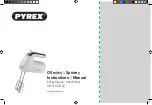
19
In-servicetests
Purpose
The purpose of in-service tests is to regularly monitor and
record the performance of the thermostatic mixing valve.
Deterioration in performance can indicate the need for
service work on the valve and/ or the water supplies.
Procedure
1.
Carry out the procedure 2. (a) to (e) on page 18 using
the same measuring equipment, or equipment to the
same specifications.
2.
If the mixed water temperature has changed signifi-
cantly from the previous test results (e.g. > 1 K), record
the change and before re-adjusting the mixed water
temperature check:
a) that any in-line or integral strainers are clean
b) any in-line or integral check valves or other anti-
backsiphonage devices are in good working order
c) any isolating valves are fully open
3.
With an acceptable mixed water temperature, com-
plete the procedure 2. (a) to (e) on page 18.
4.
If at step 2. (e) on page 18 the final mixed water tem-
perature is greater than the values in Table A and / or
the maximum temperature exceeds the corresponding
value from the previous test results by more than about
2 K, the need for service work is indicated.
NOTE: In-service tests should be carried out with a
frequency which identifies a need for service work
before an unsafe water temperature can result. In
the absence of any other instruction or guidance, the
procedure described in „Frequency of in-service tests“
may be used.
Frequency of in-service tests
TMV3*
General
In the absence of any other instruction or guidance on
the means of determining the appropriate frequency of
in-service testing, the following procedure may be used:
1.
6 to 8 weeks after commissioning carry out the tests
given in 2. on page 18.
2.
12 to 15 weeks after commissioning carry out the tests
given in 2. on page 18.
3.
Depending on the results of 1. and 4. several possibi-
lities exist:
a) If no significant changes (e.g. < 1 K) in mixed
water temperatures are recorded between com-
missioning and 1., or between commissioning and
4. the next in-service test can be deferred to 24 to
28 weeks after commissioning.
b) If small changes (e.g. 1 to 2 K) in mixed water
temperatures are recorded in only one of these pe-
riods, necessitating adjustment of the mixed water
temperature, then the next in-service test can be
deferred to 24 to 28 weeks after commissioning.
c) If small changes (e.g. 1 to 2 K) in mixed water
temperatures are recorded in both of these peri-
ods, necessitating adjustment of the mixed water
temperature, then the next in-service test should be
carried out at 18 to 21 weeks after commissioning.
d) If significant changes (e.g. > 2 K) in mixed water
temperatures are recorded in either of these
periods, necessitating service work, then the next
in-service test should be carried out at 18 to 21
weeks after commissioning.
4.
The general principle to be observed after the first 2
or 3 in-service tests is that the intervals of future tests
should be set to those which previous tests have shown
can be achieved with no more than a small change in
mixed water temperature.
*TMV2: The frequency of performing the in-
servicetestsis1yearmaximum.
Содержание Ecomax 13356000
Страница 6: ...6 X X 36 mm X 36 1 3b 2 3a 1 2 1 2 Silicone max 39 mm max 5 mm 1 2 5 4 36 mm SW 24 mm...
Страница 7: ...7 6 7 8 SW 30 mm 17 Nm...
Страница 8: ...8 Ecomax 13354000 Ecomax 13356000 R 1 2 R 1 2 P IX DVGW SVGW ACS WRAS ETA KIWA 13354000 X 13356000 X...
Страница 9: ...9 SW 3 mm SW 3 mm 2 Nm 1 3 4 2 5 6...
Страница 10: ...10 z B 42 C for example 42 C 4 3 1 2 5 1 2 S W 3 m m S W 3 m m 2 N m...
Страница 11: ...11 5 6 SW 30 mm SW 30 mm 17 Nm SW 12 mm SW 12 mm 20 Nm 4 1 1 2 2 3 1 2 SW 24 mm 1 2 SW 24 mm 20 Nm 1 2...
Страница 12: ...12 1 2 3...
Страница 13: ...13 schlie en close 90 ffnen open 1 2 kalt cold 40 C warm hot 90 1 2...


































